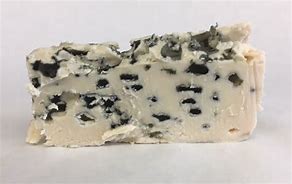Roquefort-Sur-Soulzon, France, 1411
The residents
of the town of Roquefort-Sur-Soulzon are sporting cheesy grins today. King Charles VI has given them exclusive rights to produce their famous smelly cheese. In. an effort to stamp out inferior imitations of the cheese, genuine Roquefort now can only be produced at Roquefort-Sur-Soulzon, being aged in the nearby caves that produce the particular mold that is responsible for this unique cheese.
A similar style
of cheese has been in existence since Roman times. Mention of it can even be found in the writings of the great Roman historian Pliny. The cheese was a particular favorite of the emperor Charlemagne, and a captivating legend surrounds its discovery.
The story
says that a local shepherd once thought he saw a beautiful woman in the distance and left his sheep to pursue her. He also left his lunch of rye bread and cheese in one of the dark caves of the Grotte du Combalou. When he returned some weeks later, sadly without the young woman, the air currents in the cave, combined with the dampness of the rocks, had caused an odd blue mold to grow in streaks along the surface of the ewe’s milk cheese. The shepherd ran down to the village shouting: “It’s a miracle, it’s a miracle.” The people of the town gathered around him, tasted his cheese, and liked it!
Ever since
then the limestone caves of Mount Combalou near Roquefort-Sur-Soulzon have been used for the production of this famous blue cheese. The cheesemakers still use milk from ewes that graze on the Aveyron Plateau. The cheese is white, crumbly, and slightly moist, with distinctive veins of blue mold that produce a sharp tang. It has no rind, and the exterior of the cheese is edible and slightly salty.
Next time you enjoy a piece of that cheese, remember where it came from¨Bon Appetite!
“FRENCH COOKING’S ALL VERY WELL, BUT THEY CAN’T DO A DECENT ENGLISH BREAKFAST.”
quote by: Prince Philip, England
Recent Posts
Ulrich’s GAProductions
<code Read More
The Dinosaur Eye – Wall Art
Get your Wall Picture here Read More
Hot Chocolates Restaurant and Nite Club
All your Traveling needs here at Amazon Read More
My Cosmopolitan Magazine modeling Days😁
Ulrich’s Miami Mob ordeal Read More
Ulrich’s Hot Chocolates, Fort Lauderdale, Florida, 1997 – 2001
Hike to Lake Tremorgio, Ticino, Switzerland
Daniel Humm is revolutionizing 3-Star Cuisine
This is how the first vegan menu tastes in “Eleven Madison Park” in New York... Read More
Swiss Travel Soothing Music Video
Ulrich’s Guadalajara & Mexico City Experience
Chef Ulrich in Action in Guadalajara, Mexico My first visit to Mexico was with my... Read More
Chef UlrichK on Selkirk CH.13 Cooking Show
My awkward Brandy bottle pop! The video is 16 min. long – Video is 37... Read More
Ulrich in the Dominican Republic
In 1987 I arrived in Santo Domingo to work on the re-opening of the new... Read More
Ulrich’s Miami Mob ordeal
As a Swiss chef, I took the opportunity to go and see the world, that... Read More
Exciting Swiss Family Koepf Hike to 2300 m
The Bristen (3073m) is a mountain in the Canton of Uri, Central Switzerland. ... Read More
Around Monte Baldo, Italy
On my recent visit to Verona, I came across these amazing places; situated in the... Read More
Subscribe here
Click here to Subscribe Read More
Aquaria, Thermal Waters of Sirmione
The Uniquelness of our Thermal Water Click here to visit the website The... Read More
In a MOOD for Sushi?
I am not a fan of raw fish, I like my fish cooked, especially knowing... Read More
